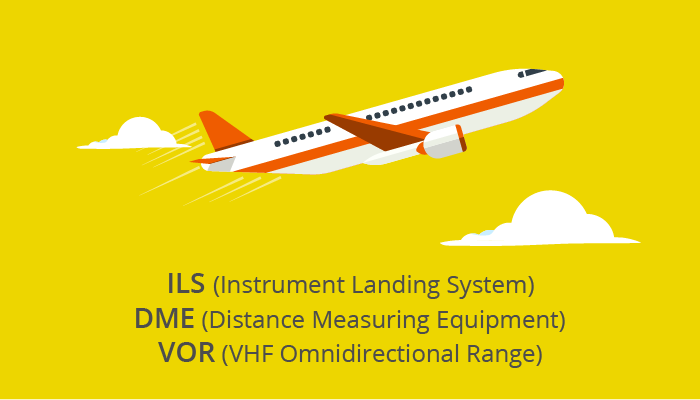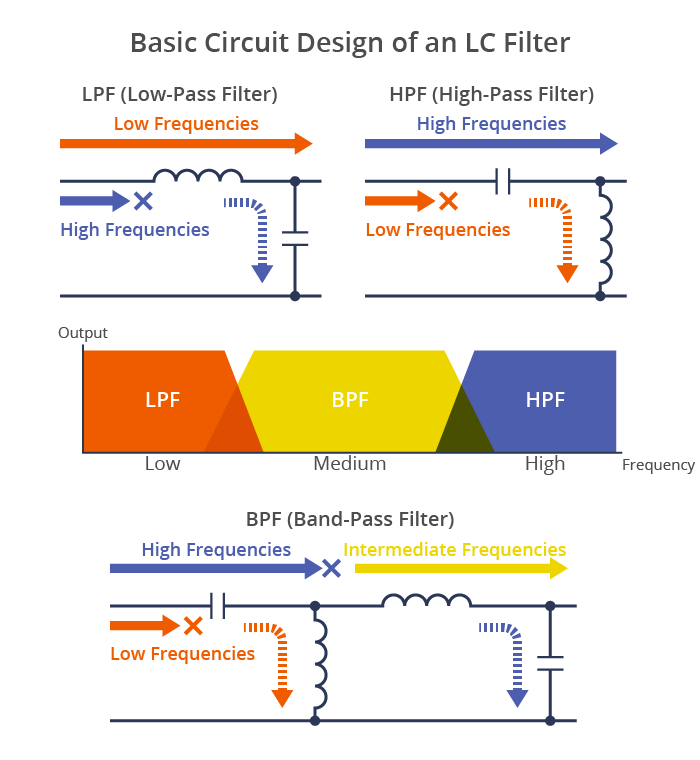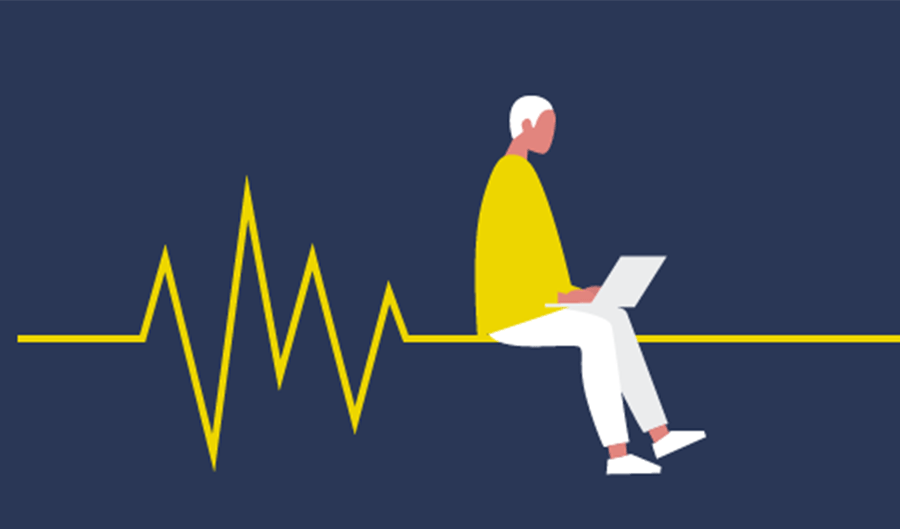
Intro to EMC Topics
Introduction to Noise (EMC) | Practical Applications—Part 1: Noise Countermeasure Technologies for the IoT/5G Era
Noise is an unavoidable problem in a thriving electronics society. This is the Practical Applications section of the Introduction to Noise (EMC) series. Various types of noise problems and their countermeasures will be presented in an easy-to-understand manner, along with real-life examples.
Noise problems have evolved over the years. This article is a prologue, exploring noise regulations for the IoT/5G era and the latest technological trends.
An electronics society cannot function without EMC technologies
The problem of noise from electronic devices first came to light in the 1960s, when microelectronics was emerging. Until then, noise problems were mainly RFI (radio frequency interference), such as interference and disturbance in wireless communications and radio and TV reception problems. The offenders and the victims were relatively clear, and the sources of noise were limited. However, as electronic devices using transistors and ICs proliferated, noise became a problem for society at large. Electronic devices weren’t only being affected by noise; the fact that they were sources of noise themselves became a rising issue. During the 1980s, as digital technologies grew rapidly, malfunctioning electronic circuits began to cause frequent incidents, such as cars with automatic transmissions suddenly stopping and darting, train doors opening fully without warning, and industrial robots causing personal injury.
Against this backdrop, the concepts of EMI (Electromagnetic Interference, or emission problems)—which is an evolved form of RFI—and EMS (Electromagnetic Susceptibility, or immunity problems) were born. EMC (Electromagnetic Compatibility) is an effort to address both EMI and EMS. In other words, EMC is the idea of preventing noise interference to other systems and being unaffected by noise from other systems simultaneously. In recent years, the proliferation of the Internet has brought many electronic devices together through wireless and wired connections. Implementing EMC measures on individual electronic devices improves the reliability of the entire system. EMC technologies are becoming increasingly important to building a convenient and safe IoT society.
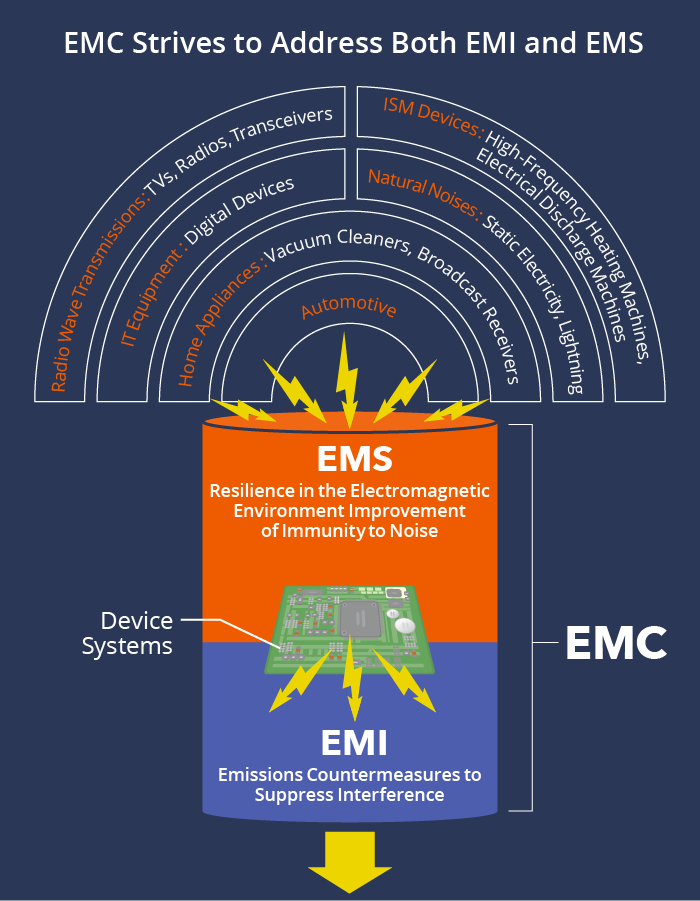
Lower drive voltages, higher clock frequencies, higher-density mounting of electronic components, and the use of plastic for enclosures have led to electronic circuits malfunctioning even at low levels of noise without EMC countermeasures.
Noise regulations are tightening worldwide
Noise is a type of environmental problem. Noise, which is a form of electromagnetic energy, knows no borders. If products without noise countermeasures are exported, damage will spread to other countries, much like cross-border pollution. International regulations have been established by the International Electrotechnical Commission (IEC) and its subsidiary organization, the International Special Committee on Radio Interference (CISPR), to minimize noise generation and harm. (EMC standards are classified into international, national and regional standards. The WTO/TBT (Agreement on Technical Barriers to Trade) recommends harmonization with international standards to ensure consistency among national standards.)
Japan’s VCCI (Voluntary Control Council for Interference by Information Technology Equipment) was established by the industry to voluntarily regulate ITE (Information Technology Equipment), such as computers, and other equipment like copiers and fax machines, in response to the 1985 CISPR recommendations. Equipment such as TVs, radios, and VCRs are subject to the Electrical Appliances and Materials Safety Act, and low-power communication devices like mobile phones are subject to the Radio Law.
Noise regulations are particularly strict in Europe. Europe, which was united as the EU in 1993, allows the CE mark to be displayed only on products that meet EMC directives and other requirements, and products without a CE mark are prohibited by law from distribution and sale within the EU. Accordingly, products without a CE mark cannot be exported to the EU.
With China joining the World Trade Organization (WTO), the CCC (China Compulsory Certificate) system was implemented. The CCC system is designed to ensure the safety of electrical and electronic products imported into China, whereby the Chinese government examines and certifies whether products conform to its GB standards (national “Guobiao” standards). Products that have not been certified cannot be shipped to, imported into, or sold in China. Certified products must also display the CCC mark. The small letters to the right of “CCC” indicate the type of certification, and “EMC” signifies electromagnetic compatibility.
In the past, ITE (Information Technology Equipment) such as personal computers were subject to regulations for radiated noise between 30MHz and 1GHz, but CISPR has decided to extend this to 6GHz, and regulations have begun. The international unification of complex noise regulations is not easy to achieve, as it involves the interests of each country. Because deliberations take long periods, it is difficult for noise regulations to keep up with the dizzying pace of electronic devices that relentlessly become more sophisticated and multifunctional.
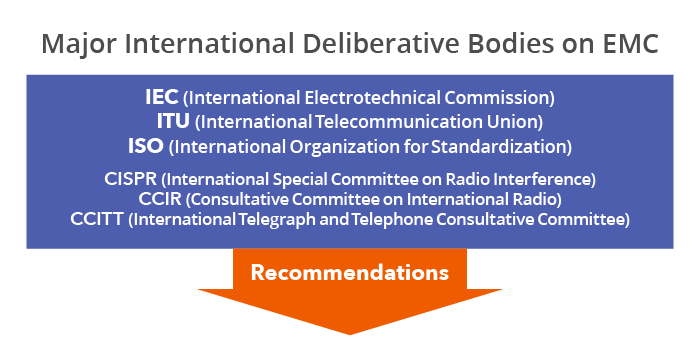
In the 1980s, the U.S. FCC led the world in regulating noise. International standards followed suit. In response to recommendations based on deliberations by representatives from each country, countries develop domestic laws and implement self-regulation.
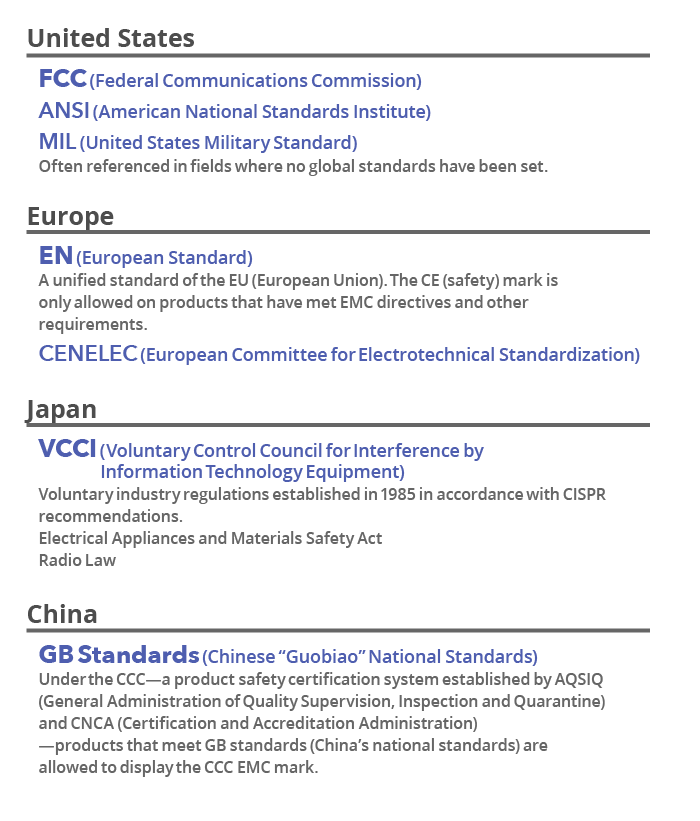
In the IoT/5G era, noise is a security matter
Full-blown television broadcasting began worldwide in the mid-20th century. Since then, TV broadcasting has evolved from black and white to color and from analog to digital. Today, television can be watched on smartphones, computers, and in cars. Even high-definition 4K/8K broadcasting has been launched. Communication speeds have grown by a factor of 10,000 times over the past 30 years and are expected to reach 1Tbps after 2030. However, a society in which anyone can access the network anytime, anywhere—is also a society in which everyone is exposed to the threat of noise and information leaks anytime, anywhere.
The noise problem cannot be addressed by thinking simplistically in terms of signals being “good” and noise being “bad.” This is because legitimate communication signals between one set of devices can be nothing but noise to others. For example, UWB is a high-speed, short-distance wireless communication technology that transmits signals by spreading them over a wide frequency range of 3 to 10 GHz. To prevent interference with other wireless devices, UWB radio waves must be held at low energy levels.
On the other hand, a new technology known as TEMPEST (electromagnetic wave eavesdropping)—which uses directional antennas to pick up weak noises emitted from computers, peripherals and cables to steal information—has emerged as a credible threat to the security of the networked society. PLC (Power Line Communication), which utilizes the existing electrical power wiring in homes and offices as a communication infrastructure, is drawing high expectations, but interference with other devices and the risk of information leaks need to be addressed before it can be put to practical use. Because the world around us is full of noise, and because there are noise sources inside electronic devices, it is impossible to completely eliminate the infiltration of noise into signals. For electronic devices in the future that will operate at increasingly higher frequencies, higher speeds and lower voltages, the concepts of SI (Signal Integrity) and PI (Power Integrity) will become crucial to maintaining the quality and stability of signals.
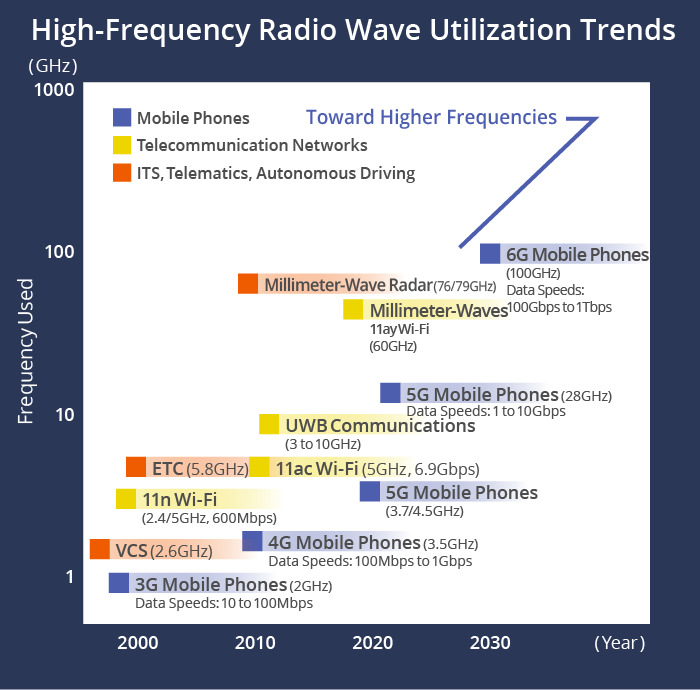
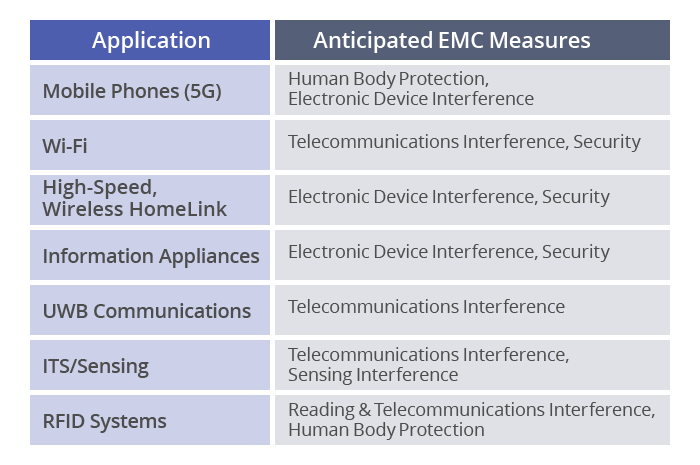
It is becoming important for EMC countermeasures in the future to incorporate the concepts of SI (Signal Integrity) and PI (Power Integrity) in order to enhance the quality and stability of signals.
TDK is a comprehensive electronic components manufacturer leading the world in magnetic technology



